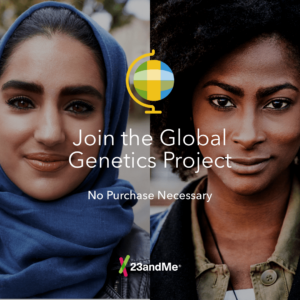The end of 2019 capped a decade of innovation in genetic research at 23andMe.
Over the last ten years, 23andMe researchers have completed or collaborated on more than 150 published studies. The pace of that discovery, and the breadth of our research, has only grown over time.
In the last year alone, 23andMe scientists have published more than 20 papers. These have covered a wide range of topics, including the genetics of certain rare genetic conditions, of same-sex sexual behavior, of BMI and breast cancer, and even gauging the attitudes and knowledge of primary care physicians on direct-to-consumer genetic testing.
In the last year, 23andMe has also undertaken some new and exciting collaborations that promise to incorporate new types of data into research.
We want to share with you some of that work with you. So here’s a look back at some of the research efforts and papers that stood out over the last year.
Ongoing Collaborations
Early on, we understood the power of 23andMe’s research model and what has become the most significant database of its kind in the world. To maximize the potential of this great resource, we established our Research Innovations Collaboration Program. This ensures that other qualified researchers will be able to use this aggregated de-identified information for important studies and enhance the impact of 23andMe’s research data.
 Among the projects we’re currently working on is one with Brigham and Women’s Hospital and the hearX Group, a collaboration we launched late last year to study hearing loss using innovative online tools. Using an online hearing test and a survey specific to the study, 23andMe was able to recruit more than 100,000 to participate in the study quickly.
Among the projects we’re currently working on is one with Brigham and Women’s Hospital and the hearX Group, a collaboration we launched late last year to study hearing loss using innovative online tools. Using an online hearing test and a survey specific to the study, 23andMe was able to recruit more than 100,000 to participate in the study quickly.
By combining an online test with a dedicated survey, this work is on track to become by far the most extensive genetic research of hearing loss ever.
Working with the Psychiatric Genomics Consortium (PGC), 23andMe has expanded its study of major depressive disorder to include not just Europeans, but African Americans, Latinos, East Asians, South Asians, and people of Middle Eastern descent. This data will be used in combination with other data by the PGC as part of what is expected to be the largest multi-ethnic study of the genetics of depression. It’s a significant effort to ensure the genetic research is representative of diverse populations.
Some Published Work
Of all the work we did this year, our collaboration with a team of international researchers on same-sex sexual behavior garnered the most attention. While the paper offered some fascinating insights into the genetics around human sexual behavior, it also illustrated the power of 23andMe’s research model. For one, the amount of phenotypic and genetic data can power studies into a complex trait like this, but it also enables the studying of sensitive and important topics. For another view, take a moment and read a perspective by Emily Drabant Conley, Ph.D. Emily, 23andMe’s vice president for business development and a former research scientist, on how this research adds to our general understanding of the human condition.
Another highlight this year was the work conducted by a former 23andMe intern Priyanka (Priya) Nakka, on the rare genetic phenomenon known as uniparental disomy. This fascinating research offered the first estimate of the frequency of this condition in the general population — it happens more than we thought. And suggest, surprisingly, that individuals with this condition can live perfectly healthy lives. Beyond all that, Priya’s work offers up another example of the kind of study that likely could not have been done if not for the scale of 23andMe’s research database. Find out more about the study in this Atlantic article, or on our blog.
Other Initiatives
There is so much more we could highlight, but instead of just one thing, we’d like to point to our efforts to improve diversity in genetic research. This is a long-term commitment that, over the years, has included 23andMe’s initiatives like
The de-identified data from the African American Sequencing Project has been made available through the National Center for Biotechnology Information’s database of Genotypes and Phenotypes (dbGaP). Now other qualified and vetted genetic researchers at educational and research institutions around the world will have access to this panel of data to improve the accuracy of their health-related genetic research on people of African American and African descent.
The work doesn’t end there, of course. But it shows our commitment to ensure that everyone ultimately will benefit from the breakthroughs in this genomic age in which we are living. You can read more about this in a perspective by Joyce Tung, our vice president of research, from early in the year.




